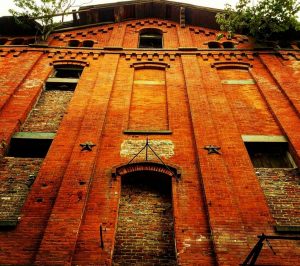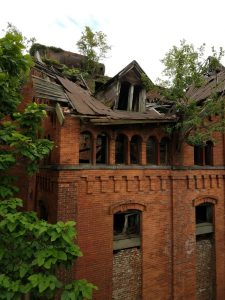In Common Spotlight: Interview with Michelle Zimmer, creator of The Bronx Was Brewing
Welcome fellow Commoners,
I’m happy to bring you all another spotlight on a #maker here at the Commons, Michelle Zimmer’s project The Bronx was Brewing.
In the years before prohibition, over sixteen hundred breweries pumped out more than 2 billion gallons of beer a year. By the end of prohibition, only a handful remained. Many of the most famous pre-prohibition breweries survived by making products other than beer–Pabst made cheese; Coors made ceramics; Yuengling made ice cream.
While most people think of Brooklyn as the flannel-clad spiritual home of the craft food movement, Zimmer (MALS 2018) offers a very different view of the brewing industry. Focusing on her home borough of The Bronx, Zimmer explores the rich brewing history of the nineteenth-century when beer was often safer to drink than water.
Zimmer’s project is ambitious, combining the digitized archival documents, original photojournalism, and a scholarly but relatable style. It is a glimpse into the thriving immigrant mecca the Bronx has always been. For me, the lesson in Zimmer’s work is that that industries die out and the cultures that arise in connection with them evolve.
Grab your favorite craft brew, and dive into this interview with Michelle Zimmer about her amazing project.
Best,
Paul
Note: This interview has been compiled from emails and notes. It has been lightly edited for style and content.

Describe your project. What’s “‘The Bronx Was Brewing’: A Digital Resource of a Lost Industry” all about?
I created the “The Bronx Was Brewing” as my capstone project for an M. A. program in Liberal Studies (MALS) at the Graduate Center. The site went live last semester and I received my master’s degree in Feb. 2018, in the New York Studies track.
In part, I created the project because the Bronx needs more scholarship that is accessible for both, a general audience and for professional scholars. The project charts the pre-prohibition history of the beer-brewing industry in the Bronx, not only telling the story of a lost industry, but also communicating a narrative of development in the Bronx.
On the website, you can explore the industry and its effects on the culture of New York City through maps, photo-essays, statistics and illustrations, organized around key themes: Immigration and Industrialization, Failure and Renaissance, The Bronx Brewers and more –including scores of historical maps, original and archival photography, and illustrations.

Talk about your inspiration for this project. How does it relate to your studies and what drew you to this specifically?
I am lifelong resident of the Bronx and when I invite people to explore the “Northside,” I usually have to assure them they won’t get a nosebleed.
Most people are completely unaware of the history of the Bronx beyond the images of urban decay from the 1970s. With prompting, people might remember the parks, Bronx Zoo, Botanical Gardens, and fine schools, but it’s the “burning Bronx” that remains the indelible image of the borough. People might be forgiven for this, however, since good digital resources about its history are often hard to find and can seem like an afterthought.
My initial, overly ambitious, plan for my capstone project was to study the Bronx through the lens of art, literature, film, foodways, and architecture. I wanted to show how this production was related to the immigrant cultures that had long histories in the Bronx. I soon realized it was too broad in scope. I then started taking to the streets and re-visiting areas I’d researched as part of my degree program. Really, I was just hoping to find something that would inspire me. It was in the South Bronx where I discovered the ruins of the Hupfel Brewery on St. Ann’s avenue and 160th street; the only nineteenth-century Bronx brewery still (barely) standing. I’d found my inspiration, and so I started to focus on “beer culture” of the South Bronx in the nineteenth-century.
In the nineteenth-century, New York City became one of the country’s largest brewing centers. The South Bronx was home to an increasingly large ethnic German community, and so was part of New York’s brewing boom. The scale of this industry was possible because, for much of the nineteenth-century, beer was deemed safer to drink than water. Add to that the introduction of the lager-style, based on German brewing traditions, and you had a product that would affect the national culture. Yet the Bronx’s brewing industry also benefited from early environmental regulation that protected water sources for the breweries, improvements in technology, and a thriving upstate New York hop-growing business.
The most famous breweries were in Manhattan and Brooklyn. Yet, the Bronx, too, played a significant role in the beer boom. One reason the Bronx’s brewing history isn’t well documented is because of New York’s changing borders. Archival documents rarely mention the Bronx because it didn’t really exist in the nineteenth-century. The area where most of the Bronx breweries were located, Morrisania, was considered part of New York County and the rest of the borough was part of Westchester. Research material on the Bronx is usually scattered, incomplete, and miscategorized.
Talk about why you chose to use the Commons for this project.
When I first met with Stephen Zweibel, the Digital Scholarship Librarian at the Graduate Center, CUNY, I needed some hand-holding. I had so many options and lots of ideas. One reason I chose the Commons is because I was overwhelmed by all of the choices and did not know where to begin!
Finally, I think it was the WordPress themes, plug-ins, GEO ranking, and personal support that sold me on the Commons. I wanted to bring together the work I had been doing in my degree program with my original research for the capstone in a way that would support both text and media.
Talk about some of the challenges you faced mounting this project on the Commons.
When I first decided to take advantage of CUNY Academic Commons, I first choose the Klean theme and then changed it to Twenty-sixteen. I had plenty of formatting problems and was driven to tears more than once. To solve my problems,I taught myself CSS code. . . sort of. Eventually, everything looked great.

I also had map issues. As soon as my Capstone was approved and I started to share the link, my map started not loading correctly.
I tweeted at the Commons and heard back almost immediately with the news that the development team was on the case. Later that day, I received an email announcing, “Solution!”. I had to activate a plug-in and the map started to work again.
Talk about some of what you’ve learned while working on this project.
Uncovering the brewing industry of the Bronx not only reveals a story of lost industry, but it also communicates a particular narrative about the development of the Bronx. The brewers were German immigrants who pioneered a thriving industry by introducing lager beer to the United States by taking advantage of the natural landscape, as well as the modernizing infrastructure.
The Bronx’s geography was perfect for the lager’s fermentation and industry in general. Surrounded by fertile land (with natural ridges, perfect for cave-fermented lager), creeks, canals, rivers, and railroad connections, the German brewers could cart in clean Adirondack water on the Croton Aqueduct, ice from upstate New York lakes, and grain from upstate farms. The industrialization and modernization of the Bronx helped the industry thrive, and was also a catalyst in its demise, as the industry eventually moved to the midwest.
Prohibition and the industrialization that expanded the industry westward brought about an end of an era and a way of life for so many Bronxites, whose livelihoods depended on the beer industry. Today, there are three breweries in the Bronx; between 1848 and 1920, there were approximately 18. The Bronx was, and now, also is brewing.

One discovery I made regarded caves which existed for lagering in the Bronx. The Hupfel and Ebling breweries were built at the base of a steep ridge, perfect for cave-lagering their beers. Eventually abandoned, in 1964 the Ebling caves inspired the final “environment” of an art exhibition called “Eat” by Allan Kaprow. Afterward, the caves sat covered until recently, when developers needed to fill in the caves for the foundational support for the construction of an apartment building. It is unfortunate that the caves were not saved.
Once, I returned to visit the once densely-populated brewery block of Third Avenue between 168th and 170th streets. On the visit, I found a low retaining wall that looked quite old. One of the bricks was loose and I was able to identify that it was made by Henry Mauer, a German-born producer of fireproof bricks known to be used in breweries. Adjacent to this wall was another ridge. I would love to learn if they hide more can caves- perhaps, the Eichler Brewery caves. All Bronx Breweries have been razed except for the Hupfel ruin. If this wall is what I think it is, then I found a section of either Kuntz, Mayer, or Liebman (producers of Rheingold) Breweries.

Talk about where you’d like the project to go now that you’ve graduated.
This project is still evolving and I want to continue adding more map layers. A second layer will focus on the beer gardens, saloons, restaurants, and casinos. Another map layer will collect news stories related to the Temperance Movement and Prohibition: news stories about arrests, padlocking of breweries, lawsuits, and criminal organizations, for example. A fourth layer will focus on urban archaeological sites and the beer related artifacts found.
I have also been invited by the Kingsbridge Historical Society to present my work.



“Many of the most famous pre-prohibition breweries survived by making products other than beer–Pabst made cheese; Coors made ceramics; Yuengling made ice cream.” The few Bronx breweries that did survive Prohibition also did so by switching to products that shared technologies with the production of beer. Ebling, Eichler, and Mayer’s produced ‘near-beer’, ice, and sold malted products, and Hupfel became a mushroom farm!